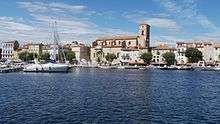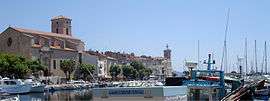La Ciotat
| La Ciotat | ||
|---|---|---|
|
Marina | ||
| ||
 La Ciotat | ||
|
Location within Provence-A.-C.d'A. region  La Ciotat | ||
| Coordinates: 43°10′37″N 5°36′31″E / 43.1769°N 5.6086°ECoordinates: 43°10′37″N 5°36′31″E / 43.1769°N 5.6086°E | ||
| Country | France | |
| Region | Provence-Alpes-Côte d'Azur | |
| Department | Bouches-du-Rhône | |
| Arrondissement | Marseille | |
| Canton | La Ciotat | |
| Intercommunality | Marseille Provence Métropole | |
| Government | ||
| • Mayor (2008–2014) | Patrick Boré | |
| Area1 | 31.46 km2 (12.15 sq mi) | |
| Population (2008)2 | 34,271 | |
| • Density | 1,100/km2 (2,800/sq mi) | |
| Time zone | CET (UTC+1) | |
| • Summer (DST) | CEST (UTC+2) | |
| INSEE/Postal code | 13028 / 13600 | |
|
1 French Land Register data, which excludes lakes, ponds, glaciers > 1 km² (0.386 sq mi or 247 acres) and river estuaries. 2 Population without double counting: residents of multiple communes (e.g., students and military personnel) only counted once. | ||
La Ciotat (French pronunciation: [lasjɔˈta]) is a commune in the Bouches-du-Rhône department in the Provence-Alpes-Côte d'Azur region in southern France. It is part of the metropolitan area of Marseille Provence. La Ciotat is located to the east of Marseille at an equal distance from Marseille and Toulon. Its inhabitants are called "Ciotadens" or "Ciotadennes".
History
La Ciotat is called "La Ciutat" or "La Ciéutat" or Cióutat" in Occitan/Provençal/Catalan, meaning "the city". It became prominent in the 15th century.
La Ciotat was the setting of one of the very first projected motion pictures, L'Arrivée d'un train en gare de La Ciotat filmed by the Lumière brothers in 1895. After several private showings, the fifty-second long film was given a public screening on December 28, 1895, in Paris, the first recorded commercial public showing of a motion picture. According to the Institut Lumière, before its Paris premiere, the film was shown to invited audiences in several French cities, including La Ciotat. It was screened at the Eden Theater in September 1896, making that theater one of the first motion picture theaters.[1]
Another three of the earliest Lumière films, Partie de cartes, l'Arroseur arrosé (the first known filmed comedy), and Repas de bébé, were also filmed in La Ciotat in 1895, at the Villa du Clos des Plages, the summer residence of the Lumière Brothers. In 1904 the Lumiere Brothers also developed the world's first colour photographs in La Ciotat [2]
In 1907 Jules Le Noir invented the game of pétanque in La Ciotat, and the first tournament was held there in 1910. The history of the game is documented in the Musée Ciotaden.[3]
Population
| Historical population | ||
|---|---|---|
| Year | Pop. | ±% |
| 1793 | 6,160 | — |
| 1800 | 6,117 | −0.7% |
| 1806 | 5,274 | −13.8% |
| 1821 | 5,237 | −0.7% |
| 1831 | 5,427 | +3.6% |
| 1836 | 5,382 | −0.8% |
| 1841 | 5,902 | +9.7% |
| 1846 | 5,429 | −8.0% |
| 1851 | 5,196 | −4.3% |
| 1856 | 7,674 | +47.7% |
| 1861 | 8,444 | +10.0% |
| 1866 | 10,017 | +18.6% |
| 1872 | 9,867 | −1.5% |
| 1876 | 10,058 | +1.9% |
| 1881 | 9,702 | −3.5% |
| 1886 | 10,682 | +10.1% |
| 1891 | 12,223 | +14.4% |
| 1896 | 12,734 | +4.2% |
| 1901 | 11,622 | −8.7% |
| 1906 | 12,370 | +6.4% |
| 1911 | 9,975 | −19.4% |
| 1921 | 10,690 | +7.2% |
| 1926 | 11,877 | +11.1% |
| 1931 | 12,425 | +4.6% |
| 1936 | 13,428 | +8.1% |
| 1946 | 13,410 | −0.1% |
| 1954 | 15,159 | +13.0% |
| 1962 | 18,827 | +24.2% |
| 1968 | 23,916 | +27.0% |
| 1975 | 32,721 | +36.8% |
| 1982 | 31,727 | −3.0% |
| 1990 | 30,620 | −3.5% |
| 1999 | 31,630 | +3.3% |
| 2008 | 34,271 | +8.3% |
| 2010 | 34,258 | −0.0% |
Commerce
La Ciotat has a large number of offices uptown. These include some big names such as Gemalto and Ball Packaging. These offices are a major source of employment and income for the local people through the transport, catering and other services they require. Also, business travelers to La Ciotat drive the local hotel business, which otherwise depends mainly on the tourism season.
Transport
The primary mode of transport into La Ciotat is the train station which is a ten minutes drive from the city centre. The SNCF train service between Marseille and Toulon stops at La Ciotat, almost every hour during the day except for the mid-day one-hour break.
Most parts of La Ciotat are covered by its public transport bus service. Although buses are not very frequent, given the small population of the city they serve their purpose. The train station is serviced by route no. 10, 21 and 40 which all go to the La Ciotat downtown station by different routes. Peak time of bus operations are from 8am to 5pm when people are working in the uptown offices of La Ciotat. After 8pm, buses cease their operation. Same is the case on weekends when buses are rare even at the train station.
Although taxis are available in La Ciotat, it is rare to hail one from the street and usually they have to be called in. Taxis are also hard to hire before 7am and after 8pm. Most call taxis are operated by individuals and are not registered with a central call service number.
The dynamics of public transport change during the summer when La Ciotat is visited by scores of tourists. At that time, more taxis service the area and buses operate more frequently.
Centre
The centre has shopping malls along with branches of Carrefour and McDonald's. Route 10 passes through the city centre on its way to downtown from the train station.
Beach
La Ciotat has an artificial sand beach because of its rocky location. The beach is located downtown and is at walking distance from local market, the ship yards and the main bus station. The beach faces the Alps mountain regions on one side and the uphill commercial area on the other side. Most hotels, restaurants and bars in La Ciotat are located on the same street.


Sport
La Ciotat has a football club, ES La Ciotat, which plays at the Stade Jean Bouissou.
The game Pétanque was invented in La Ciotat in 1907.[5]
Miscellaneous
The municipal park of La Ciotat, the Parc du Mugel, located on the Anse deu Petit Mugel, is classified as one of the Notable Gardens of France by the French Ministry of Culture. Sheltered by the massive rock called "Le Bec D'Aigle" (the eagle's beak), 155 meters high, it contains both a botanical garden of tropical plants and a nature preserve of native Provençal plants, covering the hillside below the rock.
The town has an annual film festival in early June called the 'Cinestival', and usually revolves around a specific topic. It also has two other annual film related festivals, with a scriptwriter festival in April and an associated film conference 'Berceau du cinema' around two weeks after Cinestival.[6]
Twin towns – Sister cities
La Ciotat is twinned with:
 Bridgwater, Somerset, England - since 1957[7][8]
Bridgwater, Somerset, England - since 1957[7][8] Kranj, Slovenia - since 1958
Kranj, Slovenia - since 1958 Singen, Baden-Württemberg, Germany - since 1958
Singen, Baden-Württemberg, Germany - since 1958 Torre Annunziata, Italy - since 2006
Torre Annunziata, Italy - since 2006
See also
- L'Arrivée d'un train en gare de La Ciotat, an 1896 film by the Lumière brothers
- Calanque
- Corniche des Crêtes
- Communes of the Bouches-du-Rhône department
- List of works by Louis Botinelly
References
- ↑ "Onze autres projections en France (Paris, Lyon, La Ciotat, Grenoble) et en Belgique (Bruxelles, Louvain) auront lieu avec un programme de films plus étoffé durant l’année 1895, avant la première commerciale du 28 décembre, remportant à chaque fois le même succès." From the site of the Institut Lumière in Lyon. See the website of the Institut Lumière
- ↑ The rough guide to Provence & the Cote d'Azur, ISBN 1-85828-892-4 page 212.
- ↑ Marco Foyo, Alain Dupuy, Louis Dalmas, Pétanque - Technique, Tactique, Entrainement, Robert Laffont, 1984
- ↑ Pears, Alexandria. La marine, La Ciotat. 2015
- ↑ Laurenson, John. "BBC News - Marseille Boules: The World Cup France always wins". Bbc.co.uk. Retrieved 2014-07-12.
- ↑ The rough guide to Provence & the Cote d'Azur, ISBN 1-85828-892-4 page 215
- ↑ "Bridgwater Twinning Association". Bridgwater Town Council. Retrieved 2013-07-18.
- ↑ "British towns twinned with French towns [via WaybackMachine.com]". Archant Community Media Ltd. Archived from the original on 2013-07-05. Retrieved 2013-07-12.
External links
| Wikimedia Commons has media related to La Ciotat. |
- La Ciotat Town Hall website
- La Ciotat Tourist Information Office website,
- Musée Ciotaden,
- La Ciotat International Nautical Exhibition

.svg.png)